Lamps in the kitchen above the table: varieties and placement tips
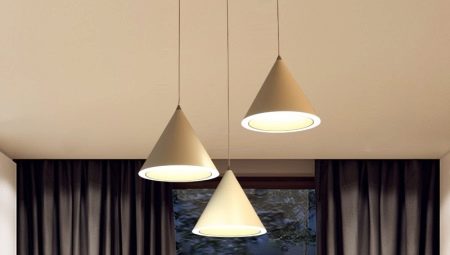
The kitchen is where we go during the day to refresh ourselves. And for the hostess, this room is also a place of work. Therefore, it is important that it is comfortable to be in it. Proper lighting plays an important role in organizing the workplace.
The article will discuss how to choose and correctly position lighting fixtures over the kitchen table.


Primary requirements
To make the cooking process convenient, you need to choose a lighting method, which will meet certain requirements.
- Comfort. In order not to get tired of the eyes, and to work comfortably, the light in the kitchen should be natural, soft and warm. In addition, the lighting should be quite bright, especially a bright kitchen lamp above the table is important.
- Saving. The kitchen is the room in which the light is on almost around the clock. Therefore, it is important to select economical LED lamps that consume little energy and last a long time.
- Simplicity. There are too many different details in the kitchen, therefore, you need to choose lamps in the minimalist style. Do not overdo it in the number and brightness of devices.
- Zoning... For many, the kitchen is combined with the dining room, which means that it is necessary to arrange the lamps so that there is light in each zone. That is, it is important that there is lighting both above the dining room, above the cutting table, and above the main kitchen tables.
- Ceiling type... Lighting largely depends on the finishing material of the ceiling. For example, a wooden ceiling requires special attention as the wood absorbs light.In this case, you can arrange pendant or recessed spotlights. Stretch, plasterboard and slatted ceilings are compatible with almost all types of lighting fixtures.
But the painted ceiling limits the choice of lighting to chandeliers, lighting panels and wall sconces.
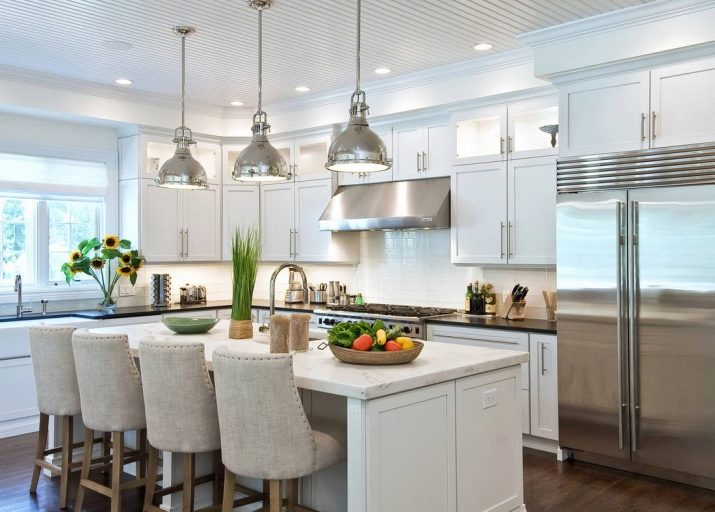
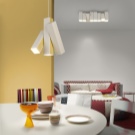

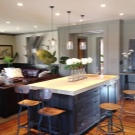
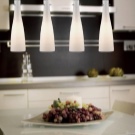
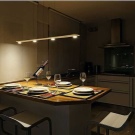
Lighting overview
Today there are a large number of types of lighting fixtures. In order not to get confused, let's consider each type separately.
- Hanging chandelier - the most common lighting device that is used to illuminate not only the kitchen, but also other rooms. Chandeliers are of various shapes, most often they are made triple, with a large number of lamps. Choose the right chandelier depending on the size and design of your kitchen. So, for a kitchen with a low ceiling, a flattened chandelier is suitable. If the size of the room allows, then you can purchase a more voluminous hanging chandelier.
The main thing is to keep it simple in choosing a suspension, so as not to overload the interior with details. If you want to soften the light, then use chandeliers with a lampshade. Most often, the chandelier acts as the main lighting device; it can be supplemented with spotlights.

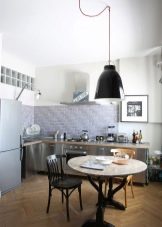

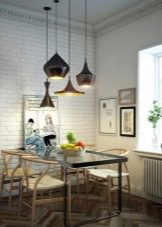
- Busbar lighting Are small luminaires located on a metal housing built into the ceiling. Sometimes the lamps can be moved along the bus, which allows you to set the light the way you want it.
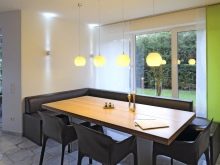
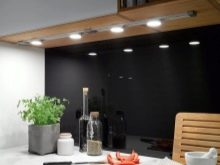
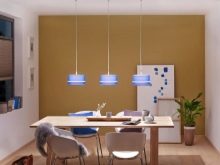
- Railing lamp This is a long, narrow lamp that is usually placed over a work table to illuminate a local area. This light fixture is easy to install and uses little energy.
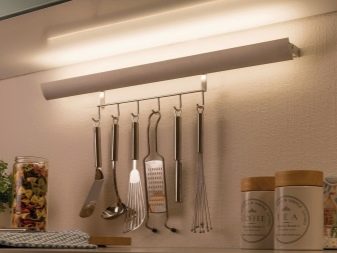
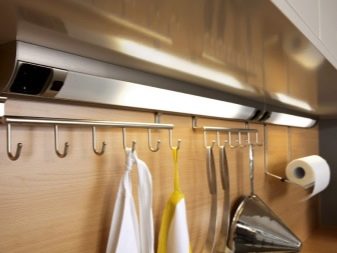
- Spot lighting It is used to evenly distribute light in the areas you need. Recently, these lamps are gaining more and more popularity, since they do not take up space at all, they are economical and efficient.
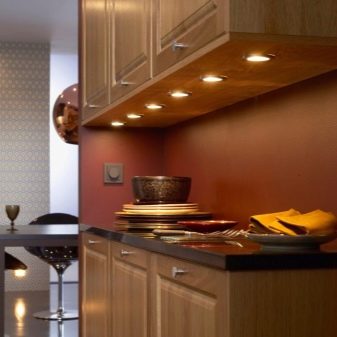
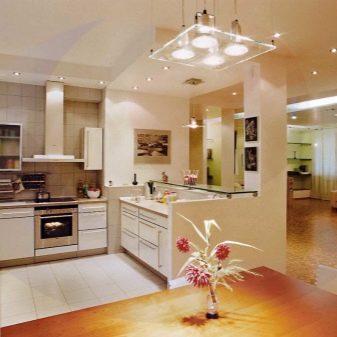
- Spot Is another interesting modern lighting device. It has the shape of a cylinder on a movable base, which allows you to direct the light in the direction you want. The luminaire can be either single or arranged in a group on the base.
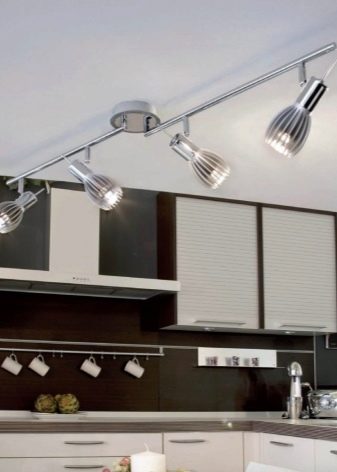
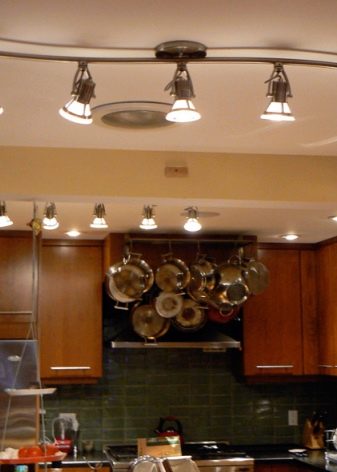
- Panel light - plays the role of the main lighting device. The sizes are different, but even the largest device does not take up much space, since it has a flattened shape.
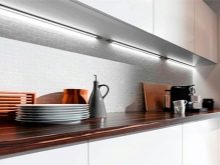
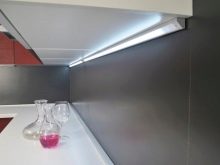
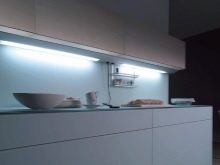
- Ceiling lighting - an interesting design solution, does not take up space at all. This is done in this way: the lamps are fixed on the ceiling itself, and a canvas is stretched over it, allowing light to pass through. This allows the soft light to be evenly diffused throughout the room.
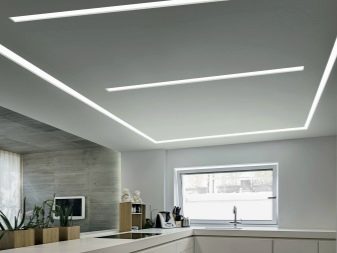
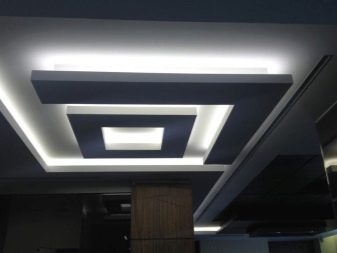
- Local luminaires. Often a central lighting fixture is not enough, as additional lighting is required above the kitchen and above the work table. For this purpose, small lamps are used. For example, wall lamps or LED strips, spotlights, wall-mounted appliances, they can be placed right above your workplace - mounted in the wall or in wall cabinets. A floor lamp can also serve as a local lighting device, but it is worth remembering that this lamp is not suitable for small-sized kitchens.
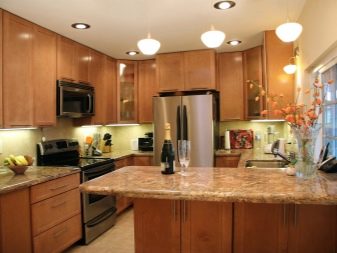
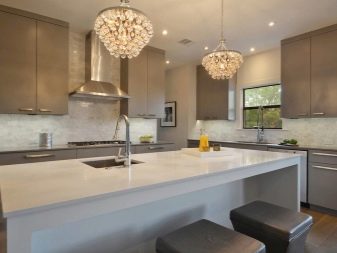
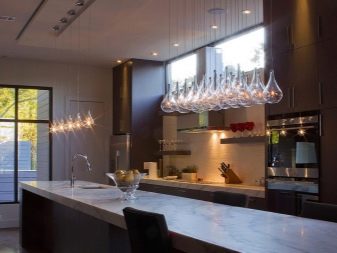
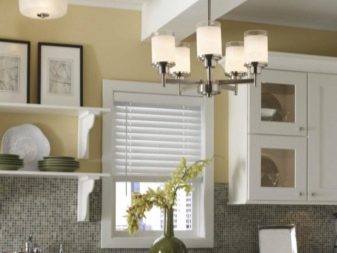
Location options
It is important to know that the kitchen can be divided into zones with the help of light. Light is a very important tool in the interior, which will help to correctly place accents and also divide the room. If the lighting is used incorrectly, mistakes can be made, which will make your stay in the kitchen uncomfortable.
First of all, you need to decide on the type of lamp for the dining table, because most often the emphasis is on the dining area. There are several options.
- A voluminous chandelier over the dining table. This option is only suitable for large kitchens. In this case, the emphasis is on the dining area, it can be supplemented with spotlights.
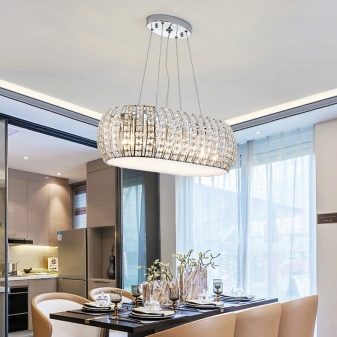
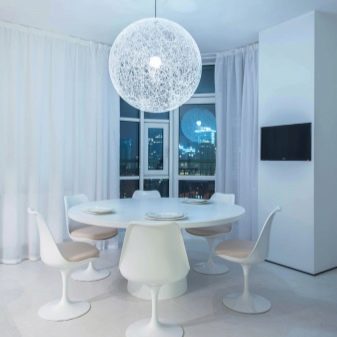
- Several lamps on a long suspension. This method provides full illumination of the dining area, scattering soft light.In addition, suspension chandeliers can be lengthened or shortened, if desired, by adding or subtracting chain links.
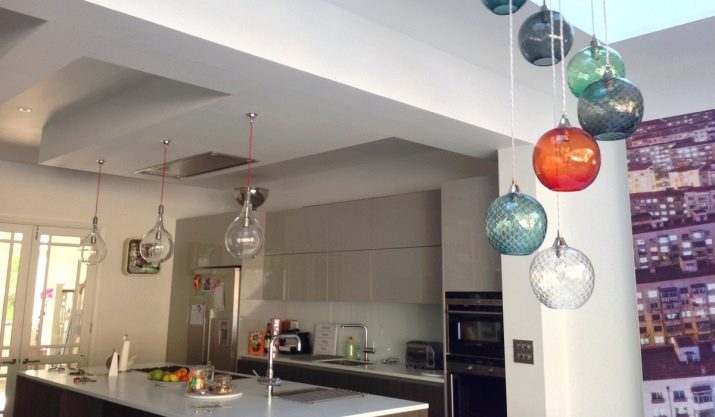
- Lighting panel, which follows the shape of the dining table, perfectly highlight the dining area.
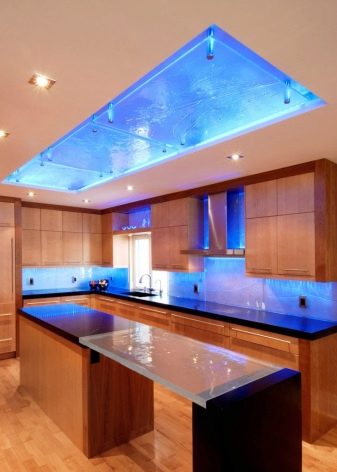
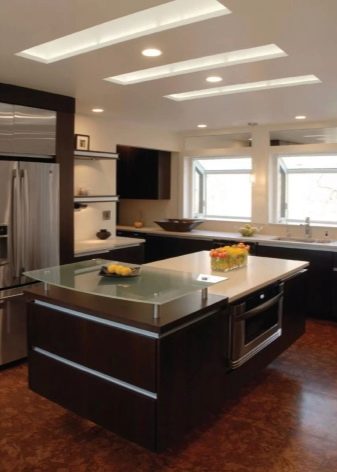
- Spotlights when positioned correctly will be an economical and interesting option. This option for placing lighting fixtures is especially suitable for a small kitchen. Choose lamps that match the style of your kitchen and the brightness you need.
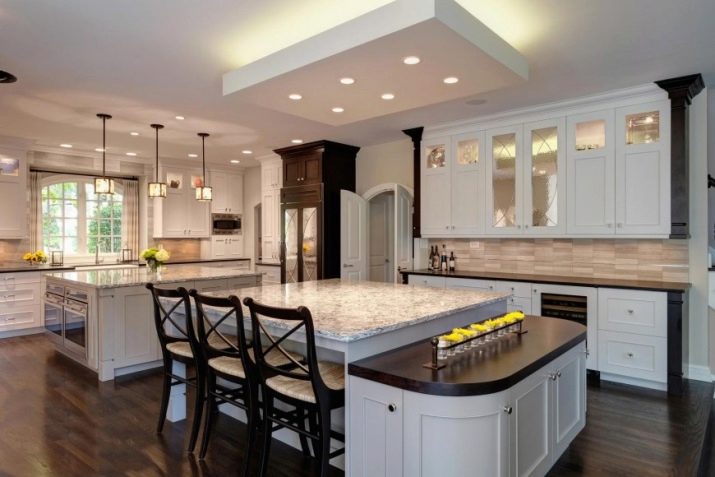
- Spots and bus lights. If you do not want to place a constant emphasis on the dining area, then use movable lamps on the bus or spots. This will allow you to choose the space you want to illuminate and direct the light in the direction you want.
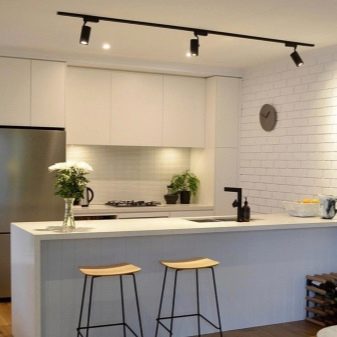
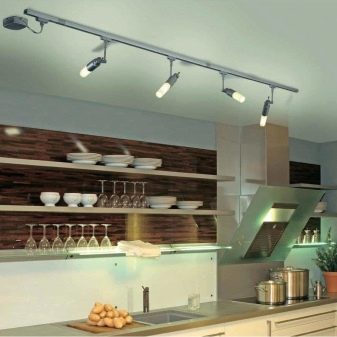
- Sconce. And also to make the light in the kitchen soft and comfortable, sconce lamps mounted on the wall will help if the table is near this wall.
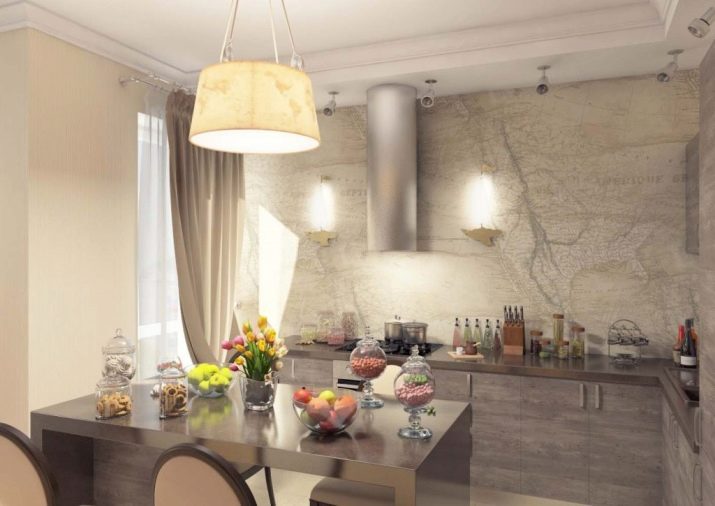
To make working in the kitchen comfortable, it is necessary to correctly place the lighting fixtures above the worktop itself. The work area, in turn, is also divided into several areas: the sink area, wall and floor cabinets and the countertop itself. Let's consider several lighting methods.
- LED Strip Light. This lamp can be placed along the entire work surface by attaching the tape to the wall cabinets, which will ensure an even distribution of light.
- Spots. As mentioned earlier, this type of fixture allows you to direct the light exactly where you need it. That is, you can get by with just a couple of lamps, directing them to the area that you are using. They can be placed both on the eaves of the wall cabinets and under them.
- Spotlights... These lighting fixtures can be integrated into kitchen furniture, making it possible to illuminate all the necessary surfaces: the shelves in the cabinets, the sink area and the countertop itself.
- Railing lamp... This lamp can be placed only above the table top, since it is quite voluminous, but the light from such a lamp spreads over the entire work surface.

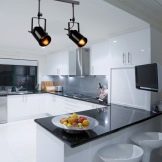
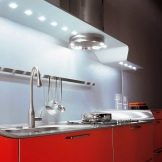
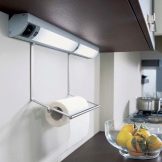
When placing lighting fixtures, it is important to consider the height of the ceilings.
For low ceilings, the location of the lamps from the floor is from 1.5 m, sconces should be placed higher so that they do not dazzle... If the ceilings are high, then the luminaires can be located 1.6 m from the floor.
How to choose a lamp?
To purchase a lamp, you need to decide on the type and size of the lamp. That is, for the dining area: pendant lamp, sconces, tire lamps or spotlights. For the working area: LED strip, spots, railing or spotlights. The choice depends on your preference.
And also it is worth deciding on the type of mounting the lighting device.
- Mortise. In this case, the luminaire is built into the ceiling itself, while its body is not visible.
- Overhead. Such luminaires are very easy to install, the body remains visible, but the lamp does not take up much space.
- Suspended. Such lamps are mounted on a bus or on a chain. It is worth noting that such lamps take up more space, but act as an interesting accent.
It is quite easy to determine the size of lighting fixtures.
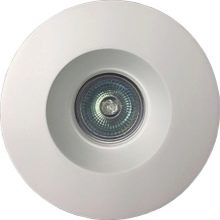
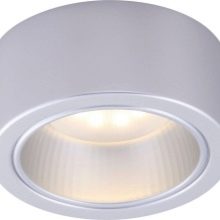
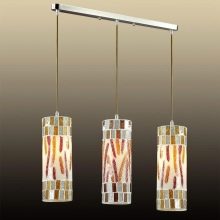
If the kitchen is small, then choose spotlights, lighting panels or spots to save space. If the kitchen is spacious, then you can choose whatever lamps you like.
Beautiful examples
In modern interiors, there are many examples of proper lighting that makes the kitchen look beautiful and lively. Consider some beautiful examples of kitchens.
- Soft diffused light in a dark kitchen due to lamps with a patterned lampshade above the work table. The lighting is complemented by spotlights along the hanging drawers and above the work surface itself.
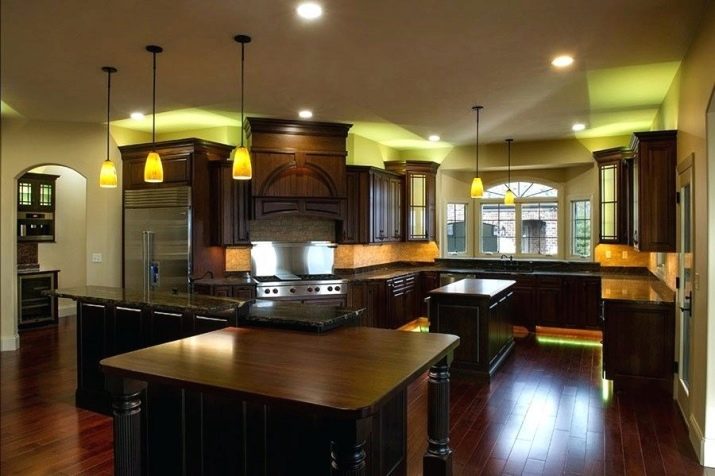
- Uniform light thanks to the correct placement of the fixtures: small pendant lamps above the dining table, as well as chandeliers throughout the area.In the role of additional lighting - spotlights above the work surface and in cabinets.
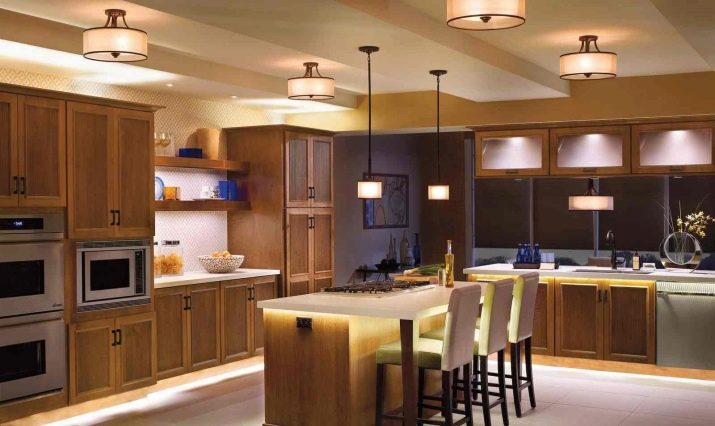
- In this case, the light in the kitchen is represented by a variety of spotlights.
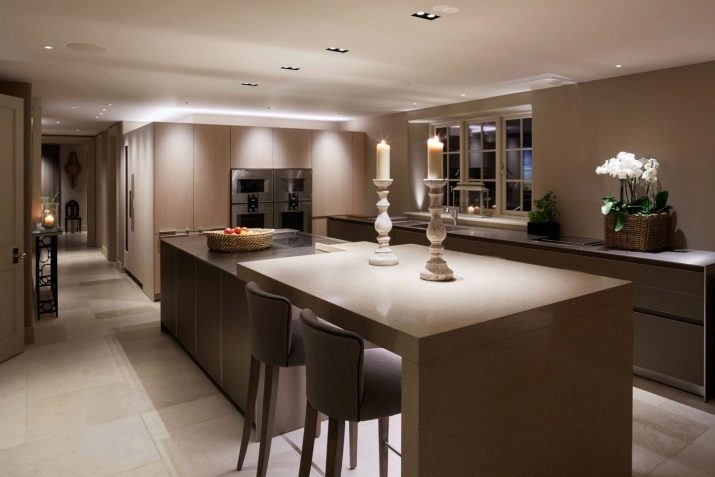
- Very nice and delicate kitchen design. The LED strip represents the main lighting, the additional spotlights.
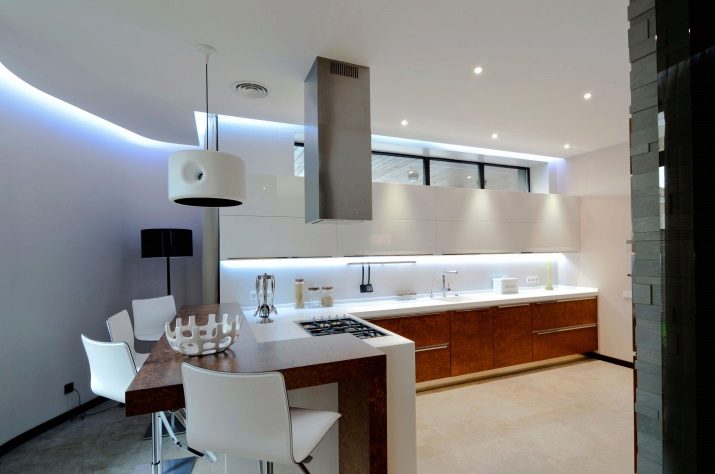
- An example of combined lighting. The lighting panel is the main light source, the secondary sources are LED strip and spotlights.
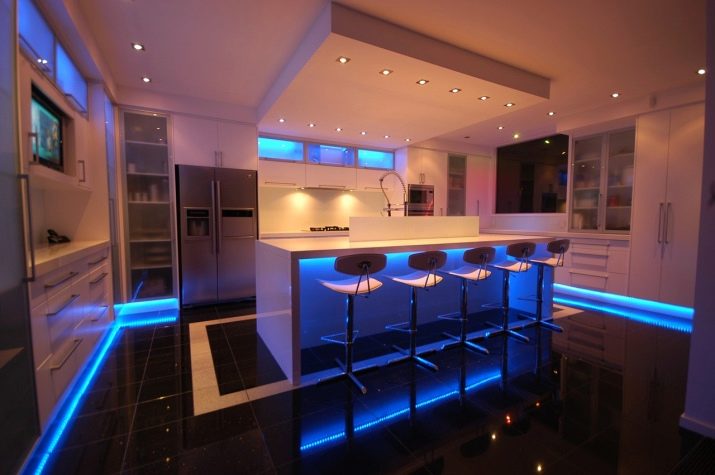
For tips on the placement of lamps in the kitchen, see the following video.








